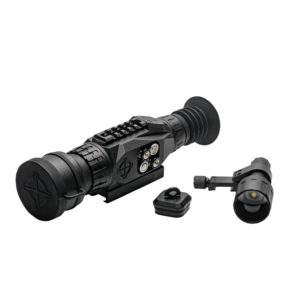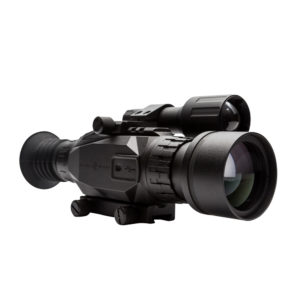As someone on a beer budget, who doesn’t hunt or feel a need to play operator in my toolshed, I’ve always had to seriously weigh my options when it comes to purchasing optics. Do I want the biggest and baddest? Absolutely! But I don’t want to have to justify to my spouse a week of ramen noodles. Gun, accessory and optic companies get this and work hard at bringing innovative products to a wide range of shooters. There are many optics companies fighting for the regular Joe and Joan’s attention. This has led to the release of advanced technology at a price point many of us can afford.
One of these companies is Sightmark, which released its brand-new digital day/night vision riflescope, Wraith at SHOT Show 2019. Sightmark has been around since 2007 and has always offered the casual AR shooter decent red dots and reflex sights for a really good price. Lately, the company has seriously upped its game in the electronic optics market and they’re vying for the top spot in the category. When comparing spec sheets, Sightmark comes out on top with more desirable features. The Wraith, I feel, has given them a chance to contend with better-known optics like ATN, FLIR and Trijicon. I had an opportunity to review the Wraith for a few days and can say that this thing is impressive!
The Wraith is a 4-32x50mm digital night vision riflescope. Digital night vision works differently than traditional night vision, allowing you to use it during the day without ruining your expensive scope. This one offers full-color high-definition images during the day and either green or black and white images at night. It offers 10 different reticle patterns in 9 different colors, adjustable brightness and a detachable IR illuminator for night use. There is 1080p on-board, high-definition recording when a Micro SD card is inserted. It operates on 4 AA batteries. Operation and menu navigation are via five different buttons conveniently located on the top of the unit. A center on/off/select button with left, right, up and down arrows.
The digital interface makes it simple to navigate and, though a beginner like me probably should have read the “how-to sight” in instructions, I’ve heard from others with more experience that sighting in is easier than with other units on the market. For me, sighting in was quite frustrating. I had never done it before and needed way more guidance than the included quick-start guide offered. (I’ve noticed that Sightmark has now posted a more extensive manual, blog post and video of how to sight in.)
I took the Wraith to the outdoor range and the indoor range. The display is crystal clear, and the bright magenta standard crosshair reticle provides a stark contrast between most backgrounds and your target. The digital zoom is smooth, and I used it in place of a spotting scope while shooting at 100 yards. Increasing the magnification is fast and nearly seamless. I didn’t experience any pixilation or problems.
At night, since the base magnification is 4x, close-up targets (25 yards) appear grainy, but you still get a positive identification of targets. The Wraith wins at 100-150 yards. Increasing magnification at further distances, things get fuzzy. You can still identify targets. I don’t imagine many people shoot hogs or coyotes from distances that reach past 200 yards, so I don’t see this being an issue.
With ambient light and standard city light pollution, objects were clear through the Wraith without IR illumination, but field of view was quite limited. The IR illuminator fixed what appeared to be some blackening around the edges and I recommend using it if you are nighttime shooting.
I did find that the IR illuminator was very bright, which I wasn’t aware of until I was done testing the brightness levels in night vision mode. This might be a beginner’s-only problem, or I had the brightness up too high for my situation. The other thing is its weight. It seems heavy. It weighs 2.30 lbs.
Sightmark recommends using high quality lithium batteries for the best battery life. I did not test continuous use, but I did get over three hours of intermediate use with no issue. Sightmark claims it can get up to five hours of battery life continuous use. I’d like to see some real testing.
I don’t have much real-life experience with other night vision devices, so it is impossible for me to make comparisons, but as an introduction into digital scopes, my experience was a good one. I would expect the retail price to be higher than it is for this quality. Overall, the Wraith is an optic that will go on my “do-want” list.




i returned my first wraith as it would not turn on in the cold. my second one doesnt like the cold either, whats going on.